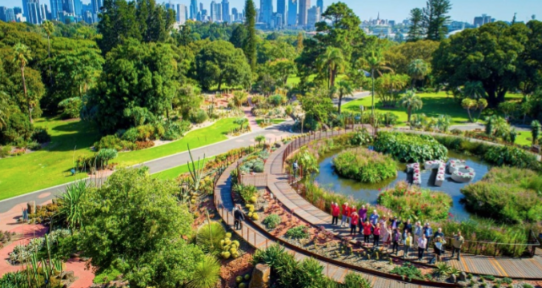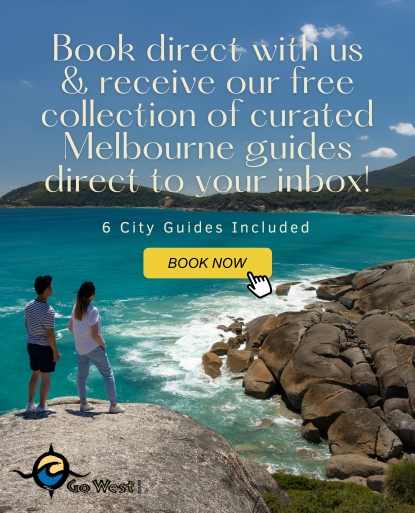Victoria’s Royal Botanic Gardens Victoria are botanical gardens that provide a welcome break from the city.
Both Royal Botanical Gardens are popular locations to visit for tourists and locals alike. One is located in Melbourne and the other one in Cranbourne. The lush greenery and open spaces provide a welcome break from the city. There is also much to learn about the flora, fauna and history of both areas.
Creating the Royal Botanical Gardens
In 1846, the Melbourne Gardens were founded, when land was reserved on the south side of the Yarra River for a new botanic garden. The garden extends across 38 hectares that slope to the river, with garden beds, lakes and trees. Almost 50,000 individual plants can be seen in the garden. These plants represent around 8,500 different species, which are displayed in 30 living plant collections.
The Cranbourne Gardens were established in 1970, when land was attained by the Gardens on Melbourne’s south-eastern urban fringe for the purpose of creating a garden only devoted to Australian plants. It was opened in 1989, for the public. The gardens exist of 363 hectares of land consisting of bushland, heathlands, wetlands and woodlands. One of the highlights of Cranbourne is the Australian Garden, which shows Australian landscapes and flora through the display of roughly 170,000 plants from 1,700 plant varieties. The Australian Garden was completed in 2012.
The State Botanical Collection is located in the Royal Botanical Gardens Victoria. The collection is housed in the National Herbarium of Victoria. The collection includes 1.5 million preserved plants, fungi and algae. It represents the largest herbarium collection in Australia and Oceania. Additionally, it includes Australia’s most comprehensive botanical library.
History and important events
The gardens are regulated under the Royal Botanic Gardens Act (1991), by the Royal Botanic Gardens Board, who are working for the Minister for Environment.
Charles La Trobe selected the site for the Royal Botanic Gardens from swamp and marshland, in 1846. The first director of the gardens was Ferdinand Von Mueller, he created the National Herbarium of Victoria and brought in many plants, in 1857.
William Guilfoyle became director in 1857. He ended up changing the style of the gardens to something more picturesque. For example, he ended up adding tropical and temperate plants.
In 1877 an important wedding occurred in the gardens. Sir Edmond Barton, who was Australia’s first Prime Minister married Jane Ross in these gardens.
The gardens brought together the elements of the organisation under the name Royal Botanic Gardens Victoria, in June 2015. This incorporated Melbourne Gardens, Cranbourne Gardens, the Australian Research Centre for Urban Ecology (ARCUE) and the National Herbarium of Victoria.
Ecology of the Royal Botanical Gardens
The Royal Botanical Gardens exist out of a mixture of non-native and native vegetation, which always hosts a diverse range of both native and non-native fauna. The gardens are home to over 10,000 floral species, with the most being non-native floral species. The Gardens were the origin for many introduced species that are spread throughout south-eastern Australia as seeds were traded between early European botanists in the 19th century.
Native vegetation
Much of the native vegetation has been removed, since the establishment of the gardens in 1846. This is due to batonists such as Baron Von Mueller planting a range of species from around the world. Initially, much of the native wetlands and swamplands were left in the gardens. However, these were relandscaped in the 20th century. They were replaced by the Ornamental Lake.
Despite this, there are still some remaining eucalypts, including the prominent Separation Tree. The Separation Tree is a three hundred year old River Red Gum, under which was declared that Victoria was a separate colony. The Separation Tree was attacked by vandals, in August of 2010. It was attacked again in 2013 and it was dead by 2015. Removal of the branches and canopy was initiated. The Royal Botanical Gardens in Cranbourne, exclusively focus on native Australian plants.
Non-Native Gardens
The gardens were initially intended to be a horticultural exhibition for the public to enjoy. Many of the seeds were started between early European botanists, who ended up planting non-native species.
Plant science
The Royal Botanical Gardens have been involved in plant research and identification, since the beginning. This is primarily done through the National Herbarium of Victoria, which is based in the gardens. It is also home to the State Botanical Collection, which contains over 1.5 million dried plant specimens, and an extensive collection of journals, books and artworks. Research findings are published in the Journal Muelleria. The journal is a scientific representation of the work done in the Gardens every year. Recently, the Australian Research Centre for Urban Ecology has been founded to look at plants that grow in urban environments in particular.
Ian Potter Foundation Garden
The botanical gardens also include a 5,000 square metre Ian Potter Foundation Children’s Garden, which is a discovery area for children of all ages and abilities. The Children’s Garden is based in South Yarra. The area is closed during 2 month every year, for renovation and maintenance purposes.
Guilfoyle’s Volcano
Guilfoyle’s Volcano is located in the Royal Botanical Gardens, Melbourne. It was built in 1876 by William Guilfoyle, the director of the gardens during this time. The inspiration of the design was possibly drawn from the volcano he saw in the New Hebrides (now called Vanuatu), during his vacation to the South Pacific in 1868.
He built the volcano in the highest part of the Botanic Gardens, with water channelling downhill to hoses at several points. He tried to address the lack of reliable water sources for the gardens in this way. Even though the Yarra River had been the gardens’ primary source. Unfortunately, the Volcano did not work out, since it took too long to refill. The gardens were connected to Melbourne’s main water supply in the 1950s and the volcano was abandoned. It was emptied, fenced off and it became overgrown in the 1980s.
In the 1990s, plans were made to revive the volcano, and it 2008 the project received enough funding. In 2010, Guilfoyle’s Volcano reopened as part of a broader stormwater capture, reticulation and filtration system. The volcano also has an extraordinary visual appeal, which prompts most visitors’ interest.
If you would like to learn more about the history of Melbourne and visit the city’s iconic attractions, join us on a Go West Tour.
Written by: Jessica Senden – Marketing Intern @gowest.com.au




